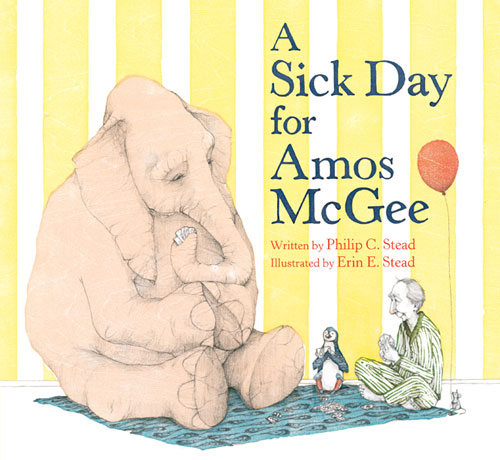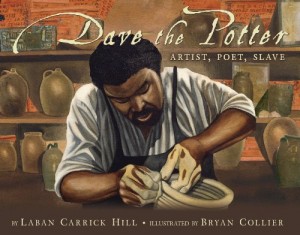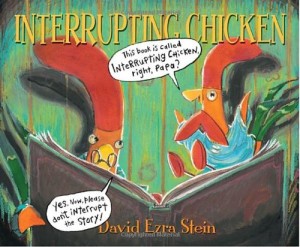 It’s hard to believe that there was once a time when full-color picture books were uncommon. It was usually an indication that the artist had somehow proved himself worthy (::cough:: Maurice Sendak) and was awarded with a full palette to use on his masterpieces (::cough:: ::cough:: Where the Wild Things Are). When you look back on the Caldecott Medal books prior to the mid-1970s, one thing that stands out is the near absence of full-color books. And it’s amazing to see what artists like Evaline Ness, Marcia Brown, and Lynd Ward were able to create with black and white or one, two, or three colors. These books don’t look at all flashy to our modern eyes, accustomed to full color. But the books are a testament to the artistic discipline and commitment to craft that we often see in the picture-book artists of yore.
It’s hard to believe that there was once a time when full-color picture books were uncommon. It was usually an indication that the artist had somehow proved himself worthy (::cough:: Maurice Sendak) and was awarded with a full palette to use on his masterpieces (::cough:: ::cough:: Where the Wild Things Are). When you look back on the Caldecott Medal books prior to the mid-1970s, one thing that stands out is the near absence of full-color books. And it’s amazing to see what artists like Evaline Ness, Marcia Brown, and Lynd Ward were able to create with black and white or one, two, or three colors. These books don’t look at all flashy to our modern eyes, accustomed to full color. But the books are a testament to the artistic discipline and commitment to craft that we often see in the picture-book artists of yore.
Erin Stead would likely be right at home among these artists. Her latest picture book, Lenny & Lucy, gracefully written by Philip Stead, is a quiet, understated story about fear, specifically fear of change, as represented by the dark woods on the other side of the bridge. Peter can see them from the bedroom window of his new house, and he knows scary things are hiding behind the trees. Accompanied by his golden retriever, Harold, he creates a gigantic figure out of blankets and pillows, names it Lenny, and places it as a sentry next to the bridge. Lenny does the job but he looks lonely, so Peter creates another pillow person, Lucy. Lenny and Lucy give Peter a bit of added security, but he doesn’t start to feel truly safe and comfortable until his new next-door neighbor Millie stops by to play.
It’s interesting to note what Stead has done with color here — or perhaps to note what she hasn’t done. She hasn’t splashed it all over the page, covering every bit of white space with pigment. She has used it sparingly — a touch of blue on Peter’s hat, gold on his jacket and shoes and all over Harold (of course), green on Lenny’s blanketed torso and pink on Lucy’s. And when Millie shows up, she’s dressed in red. These small bits of color are amplified against the monochromatic gray background used to illustrate the woods and the loud floral wallpaper on the wall in Peter’s new house. Both the woods and wallpaper loom large, and are almost claustrophobic, representing Peter’s fear of the unknown. Once he meets Millie, the woods recede, and the gray pages open up to wide white spaces.
Stead’s use of gray and white with just a bit of color demonstrates that a picture book does not need to be flashy to be distinguished. Too often, it seems, we fall victim to what I call the “magpie syndrome” — always reaching for the brightest, the shiniest, the most dazzling when we look for the best in picture books. I’m glad we have artists like Erin Stead to remind us that less is often more. Her pictures leave room for interpretation and the reader’s imagination, just as Philip Stead’s text has left room for the artist to add her own touches to the story.
It’s rare for any picture book to hit all of the criteria the Caldecott committee uses to identify a “distinguished American picture book for children.”
- Excellence of execution in the artistic technique employed;
- Excellence of pictorial interpretation of story, theme, or concept;
- Appropriateness of style of illustration to the story, theme or concept;
- Delineation of plot, theme, characters, setting, mood or information through the pictures;
- Excellence of presentation in recognition of a child audience.
This one has it all.
The post Lenny & Lucy appeared first on The Horn Book.
Hot New Releases & Popular Kids Stories
We think our list of the best new kids books for October is sensational! It highlights some amazing books from many different genres: non-fiction, reality fiction, and fantasy. Take a gander and let us know which titles and covers catch your eye ...
Read the rest of this post
 A Home for Bird has been on my radar for a long time. I was on a recon mission at ALA for new books and I sneaked a slow peek while the Roaring Brook folks were busy. It took me a while to read it because I kept slowing down. There is just so much to take in.
A Home for Bird has been on my radar for a long time. I was on a recon mission at ALA for new books and I sneaked a slow peek while the Roaring Brook folks were busy. It took me a while to read it because I kept slowing down. There is just so much to take in.
I need to admit right now that I love the loose, crayon-y strokes in this book. From the very first page (which is really the dedication page), I admired those strokes. The junker of a truck (“Careful Moving Co.”) is exactly the kind of truck my dad would have loved. There it is, spilling over with junk: a rug, chair, birdcage, fishing pole and all the rest. The grey dog hanging off the back of the truck strikes the chord many of us feel when we move. And, what’s this? A little bird has flown the coop, or been tossed out during the bump that has caused the back wheels to leave the road.
Well, that was quite a start.
The rest of the book is filled with the sort of delights that are fun to discuss. Vernon, a sweet frog with the heart of a collector, finds Bird. But, bird says nothing. Vernon concludes that Bird is missing his home, and he is just the frog to find it. The journey, “into the great unknown,” has many twists and turns until Bird does find his home. It’s these twists and turns that are so deeply satisfying. Seeing Bird in a mailbox and in another bird’s nest is sad and fun at the same time and, at some point in the visual narrative, the young reader (and older one, too!) begins to have that delicious feeling of recognition. Oh, yes, those ARE the birdcage and the tablecloth from the truck. Is that the beachball on the road? And the teddy bear! And the dog!
When Bird finally is home, Vernon is happy. It’s got that “And it was still hot” feel, doesn’t it?
Though the words are beautifully understated, this is all about the illustrations. You can understand the plot, characters and emotions from these special (in Caldecott terms, “distnguished”) pages. Still, we have a number of great themes here: friendship, home, working together, caring for others. Then there are the satisfying visual clues that draw the reader completely into the story. The art feels fresh and innocent, all gently handcrafted. If you read Jules Danielson’s interview with Mr. Stead, you will understand the work that went into this seemingly simple book. Water-soluble crayons and gouache play very well together, but, with no computer involved, the slightest mistake means starting all over again.
But, I am glad he stuck with it.

The post A Home for Bird appeared first on The Horn Book.
It’s the sniffling and sneezing season. Read more after the jump.
A Sick Day for Amos McGee, written by Philip C. Stead and illustrated by Erin E. Stead, is a feel-good book, particularly if you’re feeling under the weather. Amos McGee works at the zoo, and everyday he spends time with his friends, who come in [...]
By Bianca Schulze, The Children’s Book Review
Published: January 10, 2011
The American Library Association (ALA) announced the winner of the Randolph Caldecott Medal, for the most distinguished American picture book for children:

“A Sick Day for Amos McGee,” illustrated by Erin E. Stead, is the 2011 Caldecott Medal winner. The book was written by Philip C. Stead, and is a Neal Porter Book, published by Roaring Brook Press, a division of Holtzbrinck Publishing.
Two Caldecott Honor Books also were named:
“Dave the Potter: Artist, Poet, Slave,” illustrated by Bryan Collier, written by Laban Carrick Hill and published by Little, Brown and Company, a division of Hachette Book Group, Inc.; and “Interrupting Chicken,” written and illustrated by David Ezra Stein and published by Candlewick Press.


 It’s hard to believe that there was once a time when full-color picture books were uncommon. It was usually an indication that the artist had somehow proved himself worthy (::cough:: Maurice Sendak) and was awarded with a full palette to use on his masterpieces (::cough:: ::cough:: Where the Wild Things Are). When you look back on the Caldecott Medal books prior to the mid-1970s, one thing that stands out is the near absence of full-color books. And it’s amazing to see what artists like Evaline Ness, Marcia Brown, and Lynd Ward were able to create with black and white or one, two, or three colors. These books don’t look at all flashy to our modern eyes, accustomed to full color. But the books are a testament to the artistic discipline and commitment to craft that we often see in the picture-book artists of yore.
It’s hard to believe that there was once a time when full-color picture books were uncommon. It was usually an indication that the artist had somehow proved himself worthy (::cough:: Maurice Sendak) and was awarded with a full palette to use on his masterpieces (::cough:: ::cough:: Where the Wild Things Are). When you look back on the Caldecott Medal books prior to the mid-1970s, one thing that stands out is the near absence of full-color books. And it’s amazing to see what artists like Evaline Ness, Marcia Brown, and Lynd Ward were able to create with black and white or one, two, or three colors. These books don’t look at all flashy to our modern eyes, accustomed to full color. But the books are a testament to the artistic discipline and commitment to craft that we often see in the picture-book artists of yore.


 A Home for Bird has been on my radar for a long time. I was on a recon mission at ALA for new books and I sneaked a slow peek while the Roaring Brook folks were busy. It took me a while to read it because I kept slowing down. There is just so much to take in.
A Home for Bird has been on my radar for a long time. I was on a recon mission at ALA for new books and I sneaked a slow peek while the Roaring Brook folks were busy. It took me a while to read it because I kept slowing down. There is just so much to take in.

